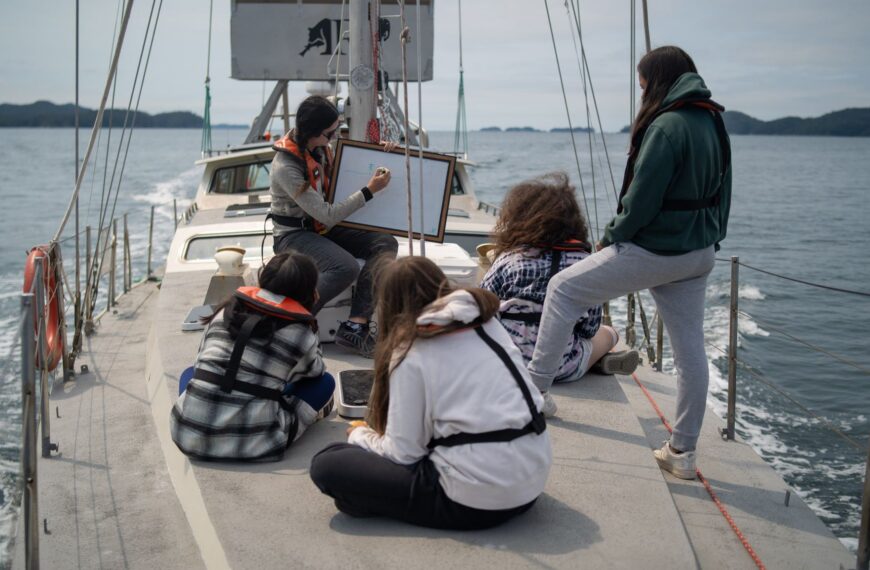Time-delayed subsidies: Interspecies population effects in salmon
New study shows the benefits from higher numbers of pink and chum salmon on spawning coho. Research was conducted by Michelle Nelson, PhD candidate at Simon Fraser University in partnership with Raincoast.
Paper:
Time-Delayed Subsidies: Interspecies Population Effects in Salmon. PlosONE. DOI: 10.1371/journal.pone.0098951
Download the PLOS ONE paper here
Abstract
Cross-boundary nutrient inputs can enhance and sustain populations of organisms in nutrient-poor recipient ecosystems. For example, Pacific salmon (Oncorhynchus spp.) can deliver large amounts of marine-derived nutrients to freshwater ecosystems through their eggs, excretion, or carcasses. This has led to the question of whether nutrients from one generation of salmon can benefit juvenile salmon from subsequent generations. In a study of 12 streams on the central coast of British Columbia, we found that the abundance of juvenile coho salmon was most closely correlated with the abundance of adult pink salmon from previous years. There was a secondary role for adult chum salmon and watershed size, followed by other physical characteristics of streams. Most of the coho sampled emerged in the spring, and had little to no direct contact with spawning salmon nutrients at the time of sampling in the summer and fall. A combination of techniques suggest that subsidies from spawning salmon can have a strong, positive, time-delayed influence on the productivity of salmon-bearing streams through indirect effects from previous spawning events. This is the first study on the impacts of nutrients from naturally-occurring spawning salmon on juvenile population abundance of other salmon species.
Press Release ~ June 9 2013
It’s generations away from qualifying as cannibalism, but newly published research co-authored by two Simon Fraser University and Raincoast Conservation Foundation scientists shows juvenile coho salmon benefit from dining on the distant remains of their spawning pink and chum cousins.
While juvenile coho salmon feed directly on spawning pink and chum salmon carcasses and eggs, even coho with no direct contact with spawning pink and chum benefit from their nutrient contributions to stream ecosystems.
The new research shows that juvenile coho abundance is up to three times higher in streams with abundant pink and chum compared to streams with none.
John Reynolds, an SFU biologist, and Michelle Nelson, one of his doctoral students, have just had their paper Time-delayed subsidies: Interspecies population effects in salmon published in PLOS ONE, an international peer-reviewed journal.
The authors say their discovery underscores the importance of understanding how a fish’s nutrient legacy in streams and forest ecosystems affects species close and distant to them.
The paper, which is one chapter of lead author Nelson’s thesis, says: “We found an indirect link between spawning pink and chum salmon, and juveniles of another species, coho.”
The carcasses of dead pink and chum salmon that have spawned in freshwater fertilize stream and forest ecosystems. The food web pathway may go from carcasses to algae to stream-insects and then to coho. Even more fascinating is a pathway that may go from carcasses to forest flies to coho.
“We know this isn’t just because all three species benefit from being in nutrient-rich streams,” says Reynolds, SFU’s Tom Buell BC Leadership Chair in Salmon Conservation. “The habitat needs of pink, chum and coho are slightly different, and even taking habitats into account, the effects of coho dining on nutrients enriched by pink and chum remains are very clear.”
“I hope this will highlight to fisheries decision-makers the ecological benefits of robust populations of spawning salmon,” says Nelson. “Pink and chum salmon have less commercial and recreational value than coho. But their crucial contribution to stream ecosystems may benefit the health of coho populations.”
Reynolds adds: “These findings are relevant to many people, considering the strong interest and connection many have with salmon. It also speaks directly to the federal Department of Fisheries and Oceans’ commitment to incorporate a better understanding of salmon-ecosystem interactions into fisheries management to conserve and restore salmon abundance in our region.”
Download the PLOS ONE paper here
Contact:
John Reynolds, 778.782.5610, 604.786.0790 (cell), Reynolds [at] sfu [dot] ca, Twitter: @JohnReynoldsSFU
Michelle Nelson (Bowen Island resident), 604.220.0214, mcnelson [at] sfu [dot] ca
Photos: http://www.somephoto.com
You can help
Raincoast’s in-house scientists, collaborating graduate students, postdoctoral fellows, and professors make us unique among conservation groups. We work with First Nations, academic institutions, government, and other NGOs to build support and inform decisions that protect aquatic and terrestrial ecosystems, and the wildlife that depend on them. We conduct ethically applied, process-oriented, and hypothesis-driven research that has immediate and relevant utility for conservation deliberations and the collective body of scientific knowledge.
We investigate to understand coastal species and processes. We inform by bringing science to decision-makers and communities. We inspire action to protect wildlife and wildlife habitats.










